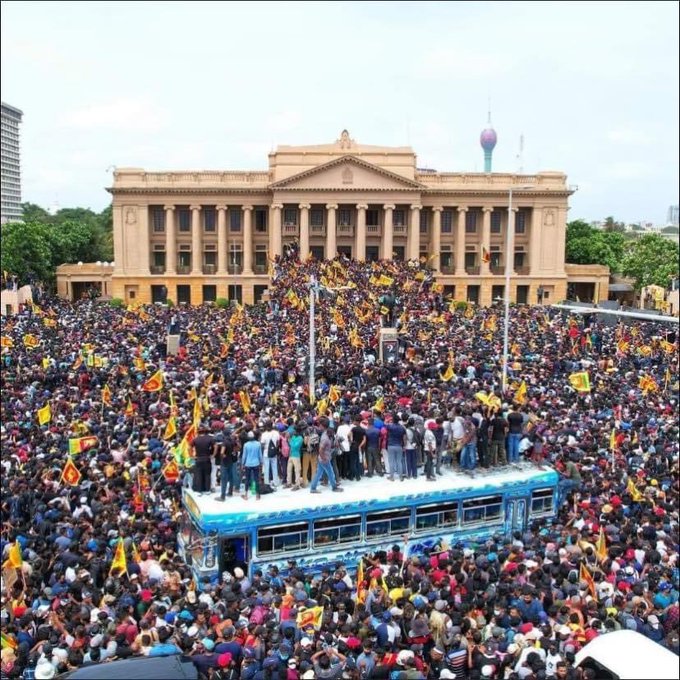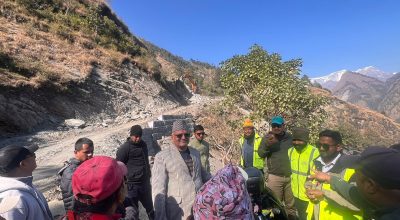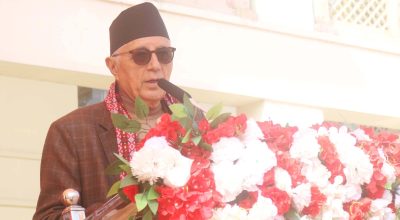
COLOMBO, Sri Lanka (AP) — Sri Lanka’s prime minister agreed to resign on Saturday after party leaders in Parliament demanded both he and the embattled president step down on the day protesters stormed the president’s residence and office in a fury over a worsening economic crisis.
Prime Minister Ranil Wickremesinghe said in a voice statement that he will resign when all parties have agreed on a new government.
“Today in this country we have a fuel crisis, a food shortage, we have the head of the World Food Program coming here and we have several matters to discuss with the IMF. Therefore, if this government leaves there should be another government,” he said.
His decision came after the biggest protest yet swept Sri Lanka as tens of thousands of people broke through barricades and entered President Gotabaya Rajapaksa’s residence and nearby office to vent their anger against a leader they hold responsible for the nation’s worst crisis.
Footage showed people in a jubilant mood taking a dip in the garden pool of the residence. Some lay on beds, others made tea and drank, and made “statements” from the conference room that Rajapaksa and Wickremesinghe must immediately quit.
Wickremesinghe said he suggested to the president to have an all-party government, but didn’t say anything about Rajapaksa’s whereabouts. Opposition parties in Parliament were currently discussing the formation of a new government.
Rajapaksa appointed Wickremesinghe as prime minister in May in the hope that the career politician would use his diplomacy and contacts to resuscitate a collapsed economy. But people’s patience wore thin as shortages of fuel, medicine and cooking gas only increased and oil reserves ran dry.
Many protesters accuse Wickremesinghe of trying to save Rajapaksa when he came under pressure to resign and every other member of his powerful political dynasty quit the Cabinet.
Later Saturday evening, protesters moved near Wickremesinghe’s home in a bid to force him to quit immediately.
Privately-owned Sirasa Television reported that at least six of their staff members including four reporters were hospitalized after they were beaten by police while covering the protest near Wickremesinghe’s home.
Sri Lanka Medical Council, the country’s top professional body, warned that the country’s hospitals were running with minimum resources and will not be able to handle any mass casualties from the unrest.
The association said that the president, prime minister and the government would be held responsible if people died or were maimed. It urged the leaders to heed the cry of the people, resign and hand over the reins to an all-party government.
It was not clear if Rajapaksa was inside his residence when it was stormed earlier Saturday. A government spokesman, Mohan Samaranayake, said he had no information about his movements.
Leaders of political parties in Parliament met later and decided to request Rajapaksa and Wickremesinghe to step down, opposition lawmaker Rauff Hakeem said on Twitter. He said a consensus was reached that the parliamentary speaker should take over as temporary president and work on an interim government.
The turmoil has led to months of protests, which have nearly dismantled the Rajapaksa political dynasty that has ruled Sri Lanka for most of the past two decades.
The president’s older brother resigned as prime minister in May after violent protests saw him seek safety at a naval base. Much of the public ire has been pointed at the Rajapaksa family, with protesters blaming them for dragging Sri Lanka into chaos with poor management and allegations of corruption.
At the president’s office, security personnel tried to stop demonstrators who pushed through fences to run across the lawns and inside the colonial-era building.
At least 34 people including two police officers were wounded in scuffles as protesters tried to enter the residence. Two of the injured are in critical condition while others sustained minor injuries, said an official at the Colombo National Hospital who spoke on condition of anonymity as he was not authorized to speak to the media.
Thousands of protesters entered the capital from the suburbs after police lifted an overnight curfew. With fuel supplies scarce, many crowded onto buses and trains to come to the city to protest, while others made their way on bicycles and on foot.
Protest and religious leaders called on Rajapaksa to step down, saying he has lost the people’s mandate.
“His claim that he was voted in by the Sinhala Buddhists is not valid now,” said Ven. Omalpe Sobitha, a prominent Buddhist leader. He urged Parliament to convene immediately to select an interim president but said that Wickremesinghe did not enjoy the people’s support.
Last month, Wickremesinghe said the country’s economy has collapsed. He said that the negotiations with the IMF have been complex because Sri Lanka was now a bankrupt state.
In April, Sri Lanka announced it is suspending repaying foreign loans due to a foreign currency shortage. Its total foreign debt amounts to $51 billion of which it must repay $28 billion by the end of 2027.
Police had imposed a curfew in Colombo and several other main urban areas on Friday night but withdrew it Saturday morning amid objections by lawyers and opposition politicians who called it illegal.
U.S. Ambassador to Sri Lanka Julie Chung on Friday asked people to protest peacefully and called for the military and police “to grant peaceful protesters the space and security to do so.”
“Chaos & force will not fix the economy or bring the political stability that Sri Lankans need right now,” Chung said in a tweet.















